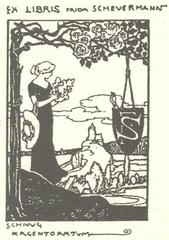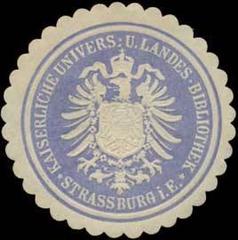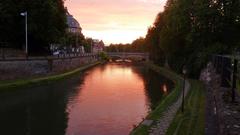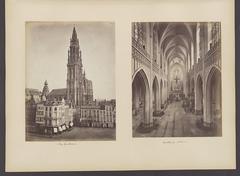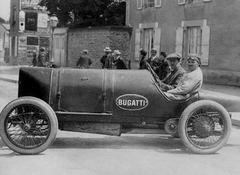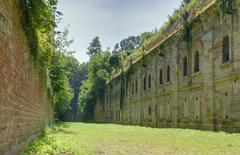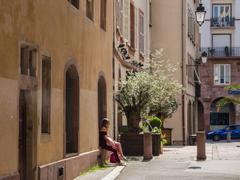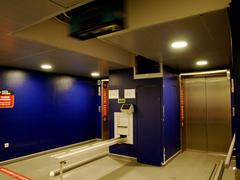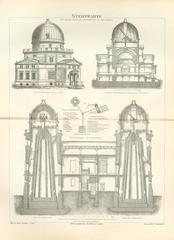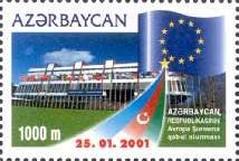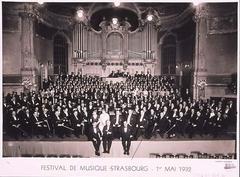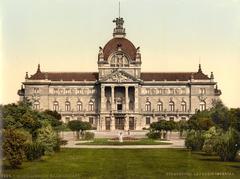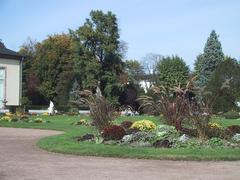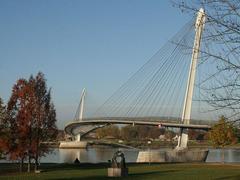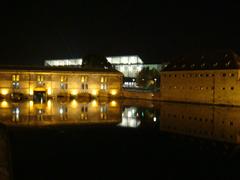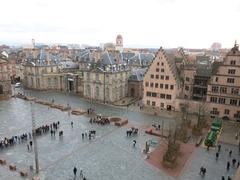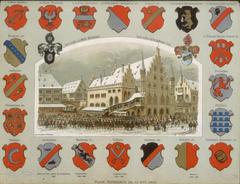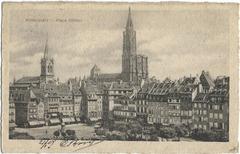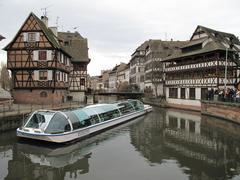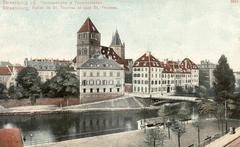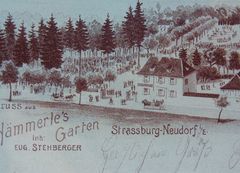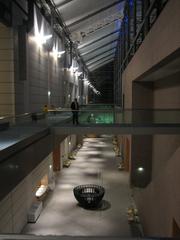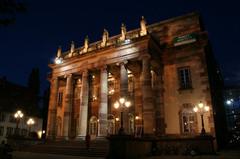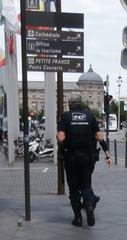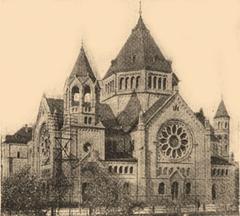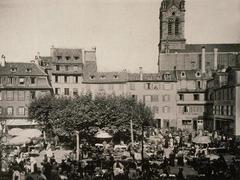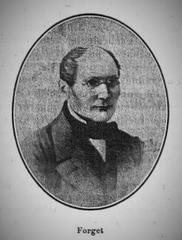Fort Hoche Visiting Hours, Tickets, and Historical Insights in Strasbourg
Date: 03/07/2025
Introduction
Fort Hoche, located on the southern edge of Strasbourg, France, is a remarkable testament to the region’s turbulent Franco-German history and military ingenuity. Constructed between 1876 and 1878 by the German Empire after the Franco-Prussian War, the fort was a key component of Strasbourg’s fortified belt, designed by renowned engineer Hans Alexis von Biehler. Today, Fort Hoche is celebrated not only for its military architecture but also as a vibrant cultural and educational site, offering guided tours, immersive exhibits, and community events (visit.alsace; fort-frere.eu).
This guide provides comprehensive information on Fort Hoche’s history, architectural significance, visiting hours, tickets, accessibility, and nearby attractions, helping you plan a memorable visit to one of Strasbourg’s most compelling historical sites.
Table of Contents
- Historical Background
- Architectural Design and Features
- Military Significance
- Preservation and Cultural Value
- Visitor Information: Hours, Tickets, and Amenities
- Guided Tours and Educational Programs
- Accessibility and Facilities
- Getting There
- Nearby Attractions
- Practical Tips
- Frequently Asked Questions (FAQ)
- References
Historical Background
Strategic Origins
Fort Hoche, originally known as Fort IXa (later Fort Schwartzhoff), was constructed by the German Empire to reinforce Strasbourg’s defenses after the city’s annexation post-1871. Its location, completing the outer ring of detached forts, was critical to safeguarding Strasbourg’s southern approaches and the Franco-German border (JDS).
Evolution Through Conflict
The fort changed hands several times, reflecting the region’s shifting sovereignty. After World War I, it was renamed to honor General Lazare Hoche. During World War II, it served various military purposes before being decommissioned. Today, it stands preserved as a symbol of reconciliation and European unity (fort-frere.eu).
Architectural Design and Features
Layout and Construction
Fort Hoche is a classic example of Biehler-type fortification, featuring a low, earth-covered profile designed to withstand artillery fire. Key features include:
- Wet Moat: Defense against infantry and mining operations
- Thick Masonry Walls: Reinforced with concrete for bomb resistance
- Caponiers and Galleries: Providing overlapping fields of fire across the moat
- Bombproof Barracks: Sheltering troops and ammunition
- Underground Tunnels: Facilitating protected movement and logistics
Its materials—mainly brick, stone, and concrete—combined with earthworks, provided resilience against late-19th-century artillery advances (fort-frere.eu).
Military Significance
Fort Hoche was one of a dozen outer forts forming Strasbourg’s defensive ring, controlling access routes from the Rhine and neighboring Germany. It was initially equipped with powerful artillery and housed a garrison capable of independent operation during sieges. Over time, the fort adapted to changes in military technology, including reinforced structures and updated communication systems (fort-frere.eu).
Preservation and Cultural Value
Surviving Structures and Integration
Much of Fort Hoche’s original infrastructure—moats, ramparts, barracks—remains intact. The site is now integrated into Strasbourg’s urban landscape and is accessible via the Route du Kuhnensand. Preservation efforts focus on maintaining structural integrity and repurposing the fort for educational and cultural use (ville-data.com).
Educational and Community Engagement
Fort Hoche hosts workshops, school visits, lectures, and community events. During France’s annual Heritage Days, the fort draws thousands for guided tours, exhibitions, and reenactments, reinforcing its role as a living monument (musiciansabroad.com; littleholidays.net).
Visitor Information: Hours, Tickets, and Amenities
Visiting Hours
- Standard Open Days: Weekends and public holidays, 10:00 AM – 6:00 PM (April–October)
- Closed: Mondays (except public holidays)
- Special Events: Extended hours during school holidays and cultural festivals
Check the official Strasbourg tourism website or contact the local tourist office for the most current schedule (visit.alsace; visitstrasbourg.fr).
Tickets and Admission
- Adults: €7
- Students/Seniors: €5
- Children under 12: Free
- Special Events/Heritage Days: Often free admission
- Group and family rates: Available with advance booking
Tickets can be purchased online or at the entrance. Advance booking is recommended for guided tours and peak periods.
Amenities
- Restrooms: Available during open days
- Café: Light refreshments and snacks
- Gift Shop: Books, souvenirs, and regional products
- Multilingual Audio Guides: French, German, English
Guided Tours and Educational Programs
Knowledgeable guides offer thematic tours in multiple languages, highlighting the fort’s history, architecture, and military role. Educational workshops and hands-on activities are available for school groups and families, often by prior arrangement (musiciansabroad.com).
Accessibility and Facilities
- Wheelchair Access: Main exhibition areas and outdoor paths are accessible; some underground spaces may be challenging.
- Support Services: Staff are available to assist visitors with special needs.
- Parking: Limited; public transport is encouraged.
Contact the site in advance to discuss specific mobility requirements.
Getting There
- By Tram: Strasbourg Tram Line C to ‘Fort Hoche’ stop
- By Bus: Several local lines serve the area (cts-strasbourg.eu)
- By Bike: Extensive cycling paths and Vélhop bike-sharing stations nearby (touristguidemap.com)
- By Car: Parking is limited, especially during events
Nearby Attractions
Enhance your visit with stops at:
- Strasbourg Cathedral
- La Petite France district
- The European Quarter
- Other forts such as Fort Kirchbach and Fort Werder
All are accessible via Strasbourg’s efficient public transport network (visitstrasbourg.fr).
Practical Tips
- Dress Comfortably: Wear sturdy shoes and bring a jacket for cool interiors
- Bring a Flashlight: Some tunnels are dimly lit
- Check Event Calendars: Heritage Days and festivals offer special programs (Strasbourg events calendar)
- Photography: Permitted, but restrictions may apply during exhibitions
- Respect Site Rules: No climbing on walls; supervision required for children
Frequently Asked Questions (FAQ)
Q: What are Fort Hoche’s visiting hours?
A: Typically open Tuesday to Sunday, 10:00 AM – 6:00 PM (April–October). Closed Mondays except public holidays.
Q: How much does admission cost?
A: €7 for adults, €5 for students/seniors, free for children under 12. Free during special events.
Q: Is Fort Hoche wheelchair accessible?
A: Main areas are accessible, but some underground sections may not be. Contact the site for assistance.
Q: Are guided tours available?
A: Yes, in several languages. Book in advance for English or German tours.
Q: Can I bring my pet?
A: Pets are generally not permitted inside the fort.
Q: Is photography allowed?
A: Yes, except where otherwise posted.
References and Further Reading
- Les forts de Strasbourg, JDS
- Fort Hoche, Visit Alsace
- La Place Forte de Strasbourg: Fort Hoche, Fort-Frère
- Fort Hoche Strasbourg, Ville-Data
- Strasbourg History on the Rhine, Musicians Abroad Blog
- Strasbourg France Travel Guide, About-France
- Strasbourg Tourist Map and Bike Paths, TouristGuideMap
- Strasbourg Official Tourism
- Strasbourg Public Transport CTS
- Best Time to Visit Strasbourg, Dabbling in Jetlag
- Strasbourg Cultural Insights, Little Holidays
Conclusion
Fort Hoche is an essential stop for history enthusiasts, architecture lovers, and anyone eager to understand Strasbourg’s unique cultural heritage. With its preserved ramparts, engaging exhibits, and accessible guided tours, the fort offers a rich, immersive experience. Plan your visit by checking current hours and ticket information, and consider joining a tour for deeper insight. For updates, event schedules, and more, download the Audiala app and follow official resources.
Explore Fort Hoche and discover how the past continues to shape Strasbourg’s vibrant present.
